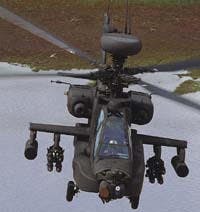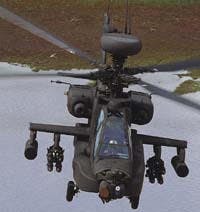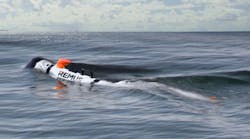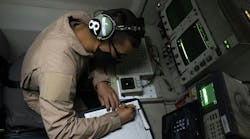Enabling technologies for military and aerospace electronics designers
DisplaysBoeing moves project ahead to install Microvision helmet-mounted displays in helicopter avionicsAvionics designers at the Boeing Phantom Works in Seattle are evaluating a prototype helmet-mounted display system from Microvision Inc. of Bothell, Wash., for potential use in future military aircraft, simulation systems and other Boeing systems."Microvision and Boeing envision that the virtual cockpit concept and its variations could be used in helicopters that are currently in the design stage, as well as in a variety of other existing military and commercial aircraft and even in ground vehicles," says Richard Edwards, manager of crew systems technology at Boeing Phantom Works.
The image quality of the display is outstanding and we are confident that the display, integrated with our software, will be an important demonstration tool for a variety of potential customers who require enhanced visualization and navigation capabilities," Edwards says.
The shipment follows Microvision's delivery and demonstration of a Virtual Cockpit Display system to the U.S. Army under Phase III of the Virtual Cockpit Optimization Program (VCOP), where Microvision and Boeing are supporting the Army's vision of how a virtual cockpit would function.
Army officials are trying to install displays into pilot helmets to electronically enhance the pilot's view. VCOP enables the pilot to see images through a wrap-around optical system that positions a pair of round lenses between the eyes and the helmet's visor.
An integrated head tracker cues system software to present images such as flight instruments, moving maps, targeting information, and intelligence onto head-up and head-down displays that appear to be superimposed on the aircraft instrument panel and on the real world scene outside of the aircraft, Microvision officials say.
The display has stereoscopic optics and electronics for two- and three-dimensional images and resolution of more than 1 million color pixels. The helmet-mounted display is designed for use with Boeing's software. This software, which integrates real-time flight reference and sensor data with planned mission parameters.
Microvision officials say that the virtual cockpit concept and its variations could be used in helicopters in the design stage, and in a variety of other military and commercial aircraft and even in ground vehicles. The goal of the VCOP system is an estimated average yearly procurement quantity of 500 systems per year and an estimated total quantity of 3,000, company officials say.
For more information contact Microvision by phone at 425-415-6847, by fax at 425-415-6600, by e-mail at sales@mvis. com, by post at P.O. Box 3008, 19910 North Creek Parkway, Bothell, Wash. 98011-3008, or on the World Wide Web at http://www.mvis.com.
ComponentsAir Force looks to Cubic to build deployable rangeless aircraft training systemU.S. Air Force officials needed deployable equipment to help tactical aircraft pilots train without the need to travel long distances to special training ranges. They found their solution from Cubic Defense Systems Inc. in San Diego.Cubic engineers are developing nine autonomous, "rangeless" air combat training systems for the Air Force and U.S. Air National Guard that use PC-based debriefing stations and refurbished airborne instrumentation "pods" that will incorporate Global Positioning System (GPS) technology.
Cubic is doing the work under terms of a $40 million contract. Teaming with cubic is Metric Systems Corp. of Fort Walton Beach, Fla., a subsidiary of Integrated Defense Technologies Inc. (IDT).
The Deployable Ground Stations will include Cubic's Individual Combat Aircrew Display System (ICADS), which enables pilots to debrief training missions on commercial Windows-based PCs or laptop computers.
The instrumentation pods, typically mounted on a wingtip weapon station, are mobile monitoring devices that collect in-flight data for post-mission debriefs. As part of the contract, the pods will be upgraded to the "P4R1" rangeless configuration.
The rangeless air combat training system will allow the rapid deployment of air combat training missions, in any available airspace, without reliance on fixed ground infrastructure, Cubic officials say.
The pods will support training for F-15 and F-16 jet fighters based at nine locations throughout the United States, Cubic officials say.
In addition to GPS technology, the pods will be configured with a tightly coupled GPS receiver/Inertial Measurement Unit package to provide tracking. The package also includes a removable digital recorder.
For more information contact the Cubic Defense Group by phone at 858-277-6780, by fax at 858-505-1523, by post at 9333 Balboa Ave., San Diego, Calif. 92123, or on the World Wide Web at http://www.cubic.com
ComputersPulse and Lockheed Martin develop digital video imaging system for Apache HelicopterOfficials at Team Apache Systems (TAS) — an organization made up of Lockheed Martin in Bethesda, Md., and Boeing in Seattle — chose Pulse Specialty Components in Bristol, Pa., to work with Lockheed Martin Missiles and Fire Control to upgrade the combat video imaging system on the U.S. Army's AH-64 Apache attack helicopter using Fibre Channel technology.Pulse Specialty Components engineers will assist in the development of a high-speed digital video transmission system using the Fibre Channel standard which is part of the modernized Apache Target Acquisition Designation Sight/Pilot Night Vision Sensor (M-TADS/PNVS) called Arrowhead, Pulse officials say. Arrowhead is Lockheed Martin's solution to the Army's requirement for an Apache M-TADS/PNVS upgrade program.
The purpose of TAS is to provide a single focus of operations and support for the M-TADS/PNVS. Arrowhead's forward-looking infrared system will help extend the U.S. Army's Apache program, Pulse officials say. Arrowhead's modernized targeting and navigation systems allow Apache pilots to fly during the day or night in adverse weather with greater safety and reliability.
Arrowhead uses digital video to enhance recording capability and facilitate still-frame video imagery transmission to the ground commander or another aircraft during normal operations, Pulse officials say. Pulse Specialty Components will supply the Fibre Channel transceiver line interface module (LIM), designed to facilitate the transfer of huge blocks of data at fiber-optic speeds ranging from 531 megabits to 1.0625 gigabits per second between the Apache's electronic equipment and mission computers, company officials say.
Fibre Channel LIMs provide the transmit/receive signal conditioning necessary for bi-directional point-to-point data transmission over common types of media, including printed circuit boards, backplanes, copper cable or fiber optic media, Pulse officials say. A high-performance, low-cost alternative to complete fiber systems, the Pulse device provides enhanced distance and signal clarity with complete inter-operability per the ANSI X3T11 Fibre Channel standard and 10-bit interface specification, company officials say.
The AH-64 Apache is the Army's primary attack helicopter. The twin-engine, four-blade, multi-mission aircraft is a quick-reacting fully integrated airborne weapons delivery platform that can fight close and low, or at standoff distances to destroy, disrupt, or delay enemy forces, Pulse officials say. The principal mission of the Apache is the destruction of high-value targets with the Hellfire missile. It also has a 30mm M230 Chain Gun cannon that is lethal against a wide variety of targets, company officials say.
The U.S. Army is upgrading its fleet of AH-64 A-model Apaches into next-generation Apache Longbow helicopters, which link a wide range of avionics, electronics, and weapons into one fully integrated weapons system, Pulse officials say.
For more information contact Pulse, A Technitrol Company, Specialty Components, by phone at 215-781-6400, by fax at 215-781-6403, by e-mail at pscsales@ pulseeng.com, by post at Two Pearl Buck Court, Bristol, Pa. 19007-6812, or on the World Wide Web at http://www.pulsespecialty.com.




